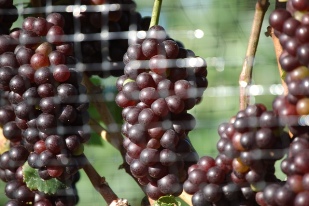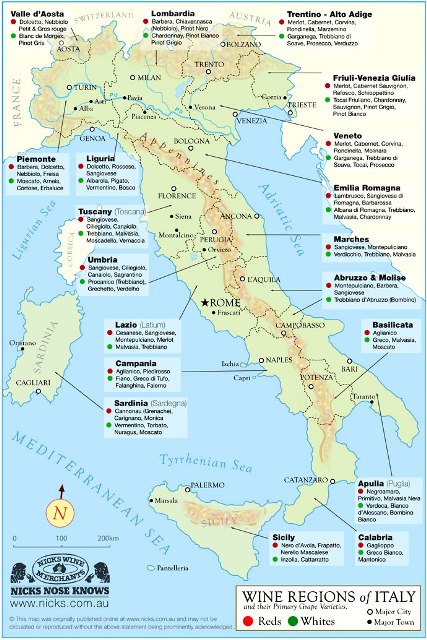|
Italian red wine, Chianti, Barbera, and Barolo keep them pouring
Italian Red Wine go to: Italian red wine is wine produced in Italy, a country which is home to some of the oldest wine-producing regions in the world. Italy is one of the world's foremost producers, responsible for approximately one-fifth of world wine production in 2005. In 2008, Italy bested France for the title of world's biggest producer for the first time in a decade, at nearly six billion liters. Red wine is exported largely around the world and have market share of over 10% in most Asian countries like India. Italian red Wine is extremely popular in Italy. Italians lead the world in wine consumption by volume with 70 literes per capita consumption, compared to 25 litres in the US, 20 litres in Australia, 40 millilitres in China and 9 millilitres in India. Grapes are grown in almost every region of the country. More than 1 million vineyards are under cultivation. Etruscans and Greek settlers produced wine in the country long before the Romans started developing their own vineyards in the 2nd century BC. Roman grape-growing and winemaking was prolific and well-organized, pioneering large-scale production and storage techniques like barrel-making and bottling.

although wines had been elaborated from the wild Vitis vinifera grape for millennia, it wasn't until the Greek colonization that wine-making flourished. Viticulture was introduced into Sicily and southern Italy by the Mycenaean Greeks, and was well established when the extensive Greek colonization transpired around 800 BC. It was during the Roman defeat of the Carthaginians (acknowledged masters of wine-making) in the 2nd century BC that Italian red wine production began to further flourish. Large-scale, slave-run plantations sprang up in many coastal areas and spread to such an extent that, in AD 92, emperor Domitian was forced to destroy a great number of vineyards in order to free up fertile land for food production. During this time, viticulture outside of Italy was prohibited under Roman law. Exports to the provinces were reciprocated in exchange for more slaves, especially from Gaul where trade was intense, according to Pliny, due to the inhabitants being besotted with Italian red wine, drinking it unmixed and without restraint. It was customary to mix wine with a good proportion of water which may otherwise have been unpalatable, making wine drinking a fundamental part of early Italian life. As the laws on provincial viticulture were relaxed, vast vineyards began to flourish in the rest of Europe, especially Gaul (present day France) and Hispania. This coincided with the cultivation of new vines, like biturica (ancestor of the Cabernets). These vineyards became hugely successful, to the point that Italy ultimately became an import centre for provincial wines. Depending on the vintage, modern Italy is the world's largest or second largest wine producer. In 2005, production was about 20% of the global total, second only to France, which produced 26%. In the same year, Italy's share in dollar value of table wine imports into the U.S. was 32%, Australia's was 24%, and France's was 20%. Along with Australia, Italy's market share has rapidly increased in recent years
Important Italian red wine-relevant geographic characteristics of Italy include:
* The extensive latitudinal range of the country permits wine growing from the Alps in the north to almost-within-sight of Africa in the south; * The fact that Italy is a peninsula with a long shoreline, contributes moderating climate to coastal wine regions; * The extensive mountains and foothills provide many altitudes for grape growing and a variety of climate and soil conditions.
Italy's 20 wine regions correspond to the 20 administrative regions. Understanding of Italian red wine becomes clearer with an understanding of the differences between each region; their cuisines reflect their indigenous wines, and vice-versa. The 36 DOCG wines are located in 13 different regions but most of them are concentrated in Piedmont and Tuscany. Among these are appellations appreciated and sought after by wine lovers around the world: Barolo, Barbaresco, and Brunello di Montalcino (colloquially known as the "Killer B's"). The regions are, roughly from Northwest to Southeast:
* Aosta Valley (Valle D'Aosta) * Piedmont (Piemonte) * Liguria * Lombardy (Lombardia) * Trentino-Alto Adige/Südtirol * Friuli-Venezia Giulia * Veneto * Emilia-Romagna * Tuscany (Toscana) * Marche (Le Marche) * Umbria * Lazio * Abruzzo * Molise * Campania * Basilicata * Apulia (Puglia) * Calabria * Sicily (Sicilia) * Sardinia (Sardegna) Wines Italy's Ministry of Agriculture and Forestry (MIRAF), has documented over 350 grapes and granted them "authorized" status. There are more than 500 other documented varietals in circulation as well. The following is a list of the most common and important of Italy's varietals. Rosso (Red)
* Sangiovese - Italy's claim to fame, the pride of Tuscany. Traditionally made, the Italian red wines are full of cherry fruit, earth, and cedar. It produces Chianti (Classico), Rosso di Montalcino, Brunello di Montalcino, Rosso di Montepulciano, Montefalco Rosso, and many others. Sangiovese is also the backbone in many of the acclaimed, modern-styled "Super-Tuscans", where it is blended with Bordeaux varietals (Cabernet Sauvignon, Merlot, and Cabernet Franc) and typically aged in French oak barrels, resulting a wine primed for the international market in the style of a typical California cabernet: oaky, high-alcohol, and a ripe, jammy, fruit-forward profile.
* Nebbiolo - The most noble of Italy's varietals. The name (meaning "little fog") refers to the autumn fog that blankets most of Piedmont where Nebbiolo is chiefly grown, and where it achieves the most successful results. A difficult grape variety to cultivate, it produces the most renowned Barolo and Barbaresco, made in province of Cuneo, along with the lesser-known Sforzato, Inferno and Sassella made in Valtellina, Ghemme and Gattinara, made in Vercelli's province. The wines are known for their elegance and power with a bouquet of wild mushroom, truffle, roses, and tar. Traditionally produced Barolo can age for fifty years-plus, and is regarded by many wine enthusiasts as the greatest Italian red wine.
* Montepulciano - The grape of this name is not to be confused with the Tuscan town of Montepulciano; it is most widely planted on the opposite coast in Abruzzo. Its wines develop silky plum-like fruit, friendly acidity, and light tannin. More recently, producers have been creating a rich, inky, extracted version of this wine, a sharp contrast to the many inferior bottles produced in the past.
* Barbera - The most widely grown Italian red wine grape of Piedmont and Southern Lombardy, most famously around the towns of Asti and Alba, and Pavia. The wines of Barbera were once simply "what you drank while waiting for the Barolo to be ready." With a new generation of wine makers, this is no longer the case. The wines are now meticulously vinified, aged Barbera gets the name "Barbera Superiore" (Superior Barbera), sometimes aged in French barrique becoming "Barbera Barricato", and intended for the international market. The wine has bright cherry fruit, a very dark color, and a food-friendly acidity.
* Corvina - Along with the varietals rondinella and molinara, this is the principal grape which makes the famous wines of the Veneto: Valpolicella and Amarone. Valpolicella wine has dark cherry fruit and spice. After the grapes undergo passito (a drying process), the wine is now called Amarone, and is extremely high in alcohol (16% and up) and full of raisin, prune, and syrupy fruits. Some Amarones can age for 40+ years and command spectacular prices. In December 2009, there was celebration when the acclaimed Amarone di Valpolicella was finally awarded its long-sought DOCG status.
* Nero d'Avola - Nearly unheard of in the international market until recent years, this native varietal of Sicily is gaining attention for its plummy fruit and sweet tannins. The quality of nero d'avola has surged in recent years.
* Dolcetto - A grape that grows alongside Barbera and Nebbiolo in Piedmont, its name means "little sweet one"", referring not to the taste of the wine, but the ease in which it grows and makes great wines, suitable for everyday drinking. Flavors of concord grape, wild blackberries and herbs permeate the wine.
* Negroamaro - The name literally means "black and bitter". A widely planted grape with its concentration in the region of Puglia, it is the backbone of the Salice Salentino: spicy, toasty, and full of dark red fruits.
* Aglianico - Considered the "noble varietal of the south," it is primarily grown in Campania and Basilicata. The name is derived from Hellenic, so it is considered a Greek transplant. Thick skinned and spicy, the wines are often both rustic and powerful.
* Sagrantino - A native to Umbria, it is only planted on 250 hectares, but the wines produced from it (either blended with Sangiovese as Rosso di Montefalco or as a pure Sagrantino) are world-renowned. Inky purple, with rustic brooding fruit and heavy tannins, these wines can age for many years.
* Malvasia Nera - Red Malvasia varietal from Piedmont. A sweet and perfumed wine, sometimes elaborated in the passito style.Other major red varieties are Ciliegolo, Gaglioppo, Lagrein, Lambrusco, Monica, Nerello Mascalese, Pignolo, Primitivo (Zinfandel in California), Refosco, Schiava, Schiopettino, Teroldego, and Uva di Troia. "International" varietals such as Merlot, Cabernet Sauvignon, Syrah, and Cabernet Franc are also widely grown.
Italian Red Wine go to: Thank you Wikipedia for the contents of this page Return from Italian Red Wine to Types of Red Wine
|
Sign up for weekly Red Wine Reviews
CLICK HEREWe will send you the extremely popular Red-Wine-Home tasting terms when you sign-up.





